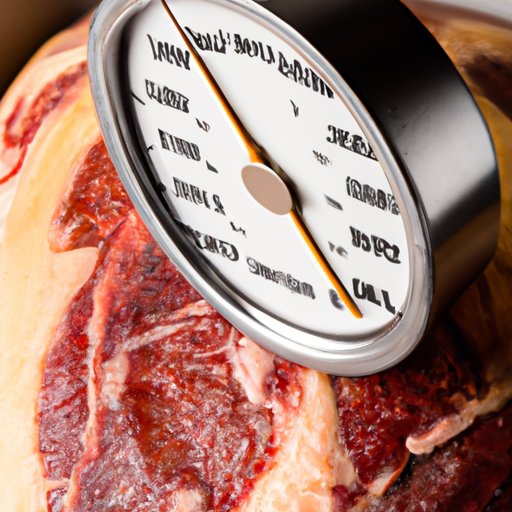
I. Introduction
Prime rib is a popular and delicious cut of meat, but it can be intimidating to cook. Many people struggle with getting the right temperature and level of doneness. In this article, we’ll explore everything you need to know about cooking prime rib to perfection. From understanding the different grades of meat to mastering cooking techniques, we’ve got you covered.
II. The Ultimate Guide: Perfect Prime Rib Every Time
Prime rib is a special cut of meat that comes from the rib section of the cow. It’s a well-marbled cut, which means it’s full of flavor and tenderness. There are different grades of prime rib, but the USDA Prime grade is considered the best quality. Look for a cut with a rich, red color and plenty of marbling.
To cook prime rib, you’ll need a few essential pieces of equipment. These include a roasting pan, a meat thermometer, and a sharp carving knife. You’ll also need ingredients like garlic, herbs, and seasoning to add flavor to the meat.
III. A Foolproof Recipe for Juicy, Tender Prime Rib
Here’s a recipe for perfectly cooked prime rib that’s sure to impress your guests:
- Remove the meat from the fridge and let it sit at room temperature for at least an hour.
- Preheat your oven to 450°F.
- Generously season the meat with your desired spices and herbs.
- Place the meat in a roasting pan and cook for 15 minutes.
- Reduce the temperature to 325°F and continue cooking for another hour and a half, or until the internal temperature of the meat reaches 135°F (for medium-rare).
- Remove the meat from the oven and let it rest for at least 20 minutes before carving.
Remember to use a meat thermometer to ensure that the meat is cooked to your desired level of doneness.
IV. The Science Behind Cooking the Perfect Prime Rib
To achieve the perfect prime rib, it’s important to understand the science behind cooking meat. The Maillard reaction is a chemical reaction that occurs when meat is cooked at high temperatures. It’s responsible for the browned, crispy exterior of the meat, and the delicious flavors that come with it. Different cooking methods and temperatures can affect the Maillard reaction and the final texture and flavor of the meat.
Using a meat thermometer is crucial in accurately monitoring the temperature of the meat. Cooking to the right temperature ensures that the meat is both safe to eat and perfectly cooked.
V. 5 Tips for Cooking Prime Rib to Perfection
Here are five tips for cooking prime rib to perfection:
- Use a dry rub or marinade to add flavor to the meat.
- Rest the meat for at least 20 minutes before carving to allow the juices to redistribute.
- Carve the meat against the grain to ensure tenderness.
- Store leftovers in an airtight container in the fridge.
- Experiment with different cooking methods and flavors to find your perfect recipe.
VI. From Rare to Well-Done: How to Cook Prime Rib to Suit Everyone’s Taste
Prime rib can be cooked to different levels of doneness to suit everyone’s taste. Here are some guidelines for achieving different levels of doneness:
- Rare (125-130°F): Cook for 10-12 minutes per pound at 450°F, then reduce the temperature to 325°F and cook until the internal temperature reaches 125-130°F.
- Medium-rare (130-135°F): Cook for 15 minutes at 450°F, then reduce the temperature to 325°F and cook until the internal temperature reaches 130-135°F.
- Medium (135-145°F): Cook for 15 minutes at 450°F, then reduce the temperature to 325°F and cook until the internal temperature reaches 135-145°F.
- Medium-well (145-155°F): Cook for 15-20 minutes per pound at 450°F, then reduce the temperature to 325°F and cook until the internal temperature reaches 145-155°F.
- Well-done (155°F and above): Cook for 15-20 minutes per pound at 450°F, then reduce the temperature to 325°F and cook until the internal temperature reaches 155°F.
VII. The Secret to a Delicious Prime Rib: Timing and Temperature
Timing and temperature are key factors in cooking perfect prime rib. It’s important to let the meat come to room temperature before cooking, as this helps it cook more evenly. Using a meat thermometer to monitor the temperature throughout the cooking process is essential. You’ll also want to factor in resting time, which allows the juices to redistribute and the meat to become more tender.
VIII. Avoid These Common Mistakes When Cooking Prime Rib
To ensure the best results, it’s important to avoid common mistakes when cooking prime rib. These include:
- Overseasoning the meat.
- Overcooking the meat.
- Not letting the meat rest before carving.
- Carving the meat with a dull knife.
- Storing leftovers improperly.
By following the tips and techniques outlined in this article, you can avoid these mistakes and achieve perfectly cooked prime rib every time.
IX. Conclusion
Cooking prime rib can be intimidating, but with the right techniques, it’s easy to achieve perfectly cooked, juicy, and flavorful meat. By understanding the science behind cooking meat, using a meat thermometer, and following our tips and techniques, you’ll be able to impress your guests with your cooking skills. Remember to experiment with different flavors and methods to find your perfect recipe.





